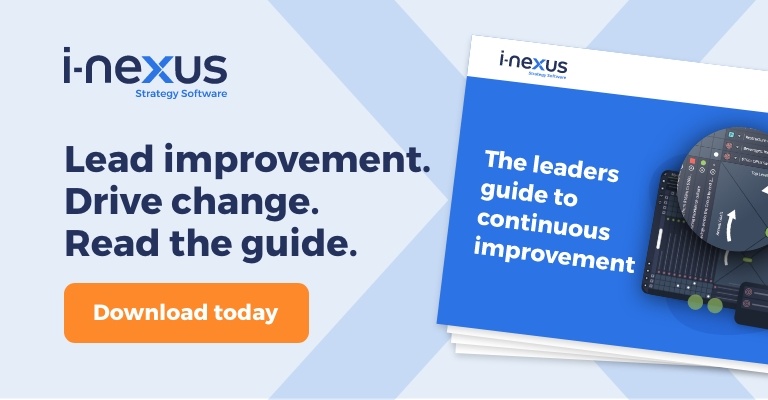Continuous improvement can range from simple projects where it’s a case of ‘just do it’, or they can be longer-term projects. From DMAIC, to root cause analysis and beyond, these are the core tools and techniques which drive sustainable change.
Written by: Nigel Richardson
Once you start to scope, define and deliver improvement you turn to address how the improvement is managed through an appropriate level of structure to ensure you are delivering the right improvement in the right way to give you sustainable results.
The two main factors to consider when forming a judgement on the appropriate level of structure are:
1) The stakes
How impactful is this business problem, what are the stakes of failure and how large is the performance challenge?
2) The urgency
When does this need delivering by?
There is no point delaying your improvement due to layers on unnecessary tool application.
Done is mostly better than perfect.
Continuous improvement frameworks
Below are some suggested levels of improvement that I have seen built it in a variety of functions and industries.
1) The quick fix or just do it
Make it happen and capture it is done.
A simple log of what was done, why, and the expected benefit to the business performance is all you need.
If you collate these, they can become something more powerful.
Action lists, Concern and Countermeasure Sheets, any form of log is a powerful reminder of the steps being taken over time no matter how small.
If you invest in the basics from the section above to ensure business performance is the data driven focus you will reap the rewards.
2) Countermeasures or corrective actions
These are a base level structure that can be applied to any gap in operational performance or issue resolution.
They are often a blend of items A and C in this list in the following logic:
a) What is the quick fix or containment action we implement quickly?
The goal here is to stop the problem getting worse and take the pain away from the customer.
In this context ‘sticking plaster’ solutions are completely valid.
b) Root cause analysis
With the above in place you now can investigate through your appropriate root cause approach to define and implement your corrective actions.
c) Preventative action
Once the problem is fixed there is a further round of review for preventative actions to prevent this happening again either in the same part of the business or other related parts of the business where this situation could occur.
d) The impact
It is often the case that the continuous improvement community within a business truly earn their credibility when they step up to lead this type of exercise.
In my experience a well-run Investigation of an impactful quality or customer issue can often create the focus of your continuous improvement deployment for the next couple of years.
That is truly continuous improvement.
3) Root Cause problem solving
Where the operational conversations do not yield a quick fix, a level of structure is needed to investigate the problem, define the root causes and define and deliver the required improvements in a sustainable way.
To ensure this level of improvement works there needs to be investment in the structure behind:
a) Defining the business problem
What is the problem? Why is it bad? When and where does it occur?
How do you detect it? Who is involved?
b) A structured root cause analysis
A team of people with the relevant breadth and depth of knowledge of the business have a joint conversation or workshop to map out the relationships between the observed effects and contributing causes.
The root causes that you choose to define improvements around will be based on a mixture of:
- Prioritization: Which causes are creating the most, often multiple, impacts, and
- Pragmatism: Which causes do we have the ability to influence in the time we have with the support we have?
Root cause analysis can tend to create a perception that a problem is insurmountable, a huge organizational effort even.
My guidance has always been to design improvements around what is within your ability to influence.
If others see you are doing what you can then you are more likely to get additional support or budget to push harder.
c) The 5 Whys
My absolute favorite facilitation tool in this context.
It gives you the freedom to ensure that the resulting activity is not just to a satisfactory depth (i.e. somewhere close to the 5th why level), but it also covers an appropriate breadth.
No cause effect relationship is a single straight line. A single cause can influence multiple effects and the more you can view this as an overall landscape the more powerful it is.
Other favored tools to visualize cause and effect include Fishbone analysis or the Affinity diagram.
4) The Improvement Project
a) DMAIC (Define, Measure, Analyze, Improve, Control)
Generally, running in a structured set of phases my go to standard in this space for many, many years is DMAIC.
DMAIC has been covered in our chronicle of Six Sigma’s history but, from my experience working in companies that applied both Lean and Six Sigma approaches, DMAIC served as a base set of phases for any form of improvement.
The headings may change, but the goals of each stage are roughly the same so I will use DMAIC as a core frame of reference.
It is vital that you have some form of framework for your improvement delivery to ensure that outcomes are actually delivered having invested so heavily in the up-front activity and engagement of teams.
The tools and techniques that exist are successful due to one single point of reality that I have faced after 20 years of applying this:
- Individuals have common sense, groups do not
- On paper the tools appear simple and were you to fill them out on your own at your desk you would likely wonder what all the fuss was about.
However, most of the time they serve as a very effective facilitation tool by visualizing the thought process you are going through, and establishing a logical story, allowing you to:
- Facilitate a group with differing perspectives to a common understanding
- Be able to share and communicate your team’s output at various stages in an engaging way that ‘shows your working’
Regardless of the improvement method definition in my experience the tools and techniques can be grouped around three categories:
1) Project Management
Taking your activity to a logical conclusion from the initial discussion to closing the improvement as sustainably implemented as part of business as usual.
A level of project management keeps you and your stakeholders honest and focused.
This is the competency that ensures that the people you rely on for improvement deliver an improvement rather than act as a facilitation support function.
2) Diagnostic
Helping you define the problem and the current state reality in your business. The output will be highly specialized to your industry and your reality.
The standard and structure comes from how to collect, manipulate, analyze and visualize information that you learn either from a data collection or process observation perspective.
Most of the Six Sigma derived tools and techniques are of this nature.
3) Improvement Intervention
These are a proven predefined set of principles and ways of working that you can apply to improve your business.
Most of the Lean toolbox is comprised of these predefined improvement tools or playbooks for you to follow to add value in your business.
When you consider the plethora or opportunities in these categories it becomes a lot clearer as to how companies successfully combine Lean and Six Sigma in a single integrated end to end improvement method.
Continue learning about continuous improvement
Click here to learn more about continuous improvement, or take a look at these content recommendations:
- Continuous improvement in 2020 and beyond: Watch how continuous improvement will evolve into the 2020s and how you can be successful.
- DMAIC v Six Sigma v Lean: Our guide to the steps and tools you'll need when driving process improvement through one of these three methodologies.
- The Leader's Guide to Continuous Improvement: Download this eBook to get a comprehensive overview of how DMAIC, Six Sigma, Lean, PDCA can support your business in finding competitive advantage.
About the author
Nigel Richardson is a continuous improvement expert. His background spans 20 years in business transformation and continuous improvement across retail, pharma, aviation and IT supply chain. He is passionate about supporting organizations to achieve their strategic, transformational and improvement goals, and outperform their peers year after year.
If you’d like to talk more about your strategic challenges, reach out to him on nigel.richardson@i-nexus.com or connect with Nigel on LinkedIn for the latest Strategy Execution insights.







